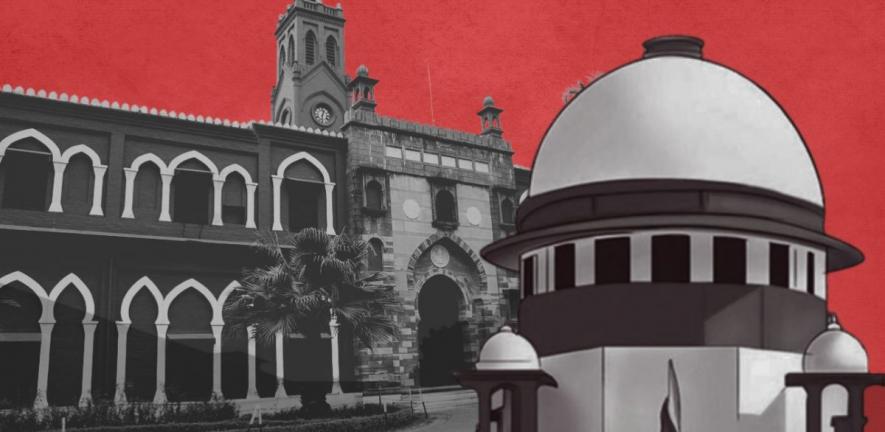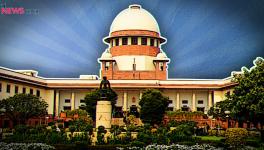AMU Minority Status Case: A Comprehensive Summary of the Eight Days of Hearings

What transpired during the eight-day-long proceedings before a seven-judge Bench of the Supreme Court of India to determine whether Aligarh Muslim University is a minority institution? Read this comprehensive summary.
—
Aligarh Muslim University (AMU) has found itself at the epicentre of the legal discourse about its historical evolution and constitutional challenges.
Originating in 1877 as Muhammadan Anglo-Oriental College (MAO College), founded by Sir Syed Ahmed Khan, AMU was subsequently incorporated through the Aligarh Muslim University Act, 1920 (AMU Act). Key amendments, such as those in 1951 and 1965 significantly impacted religious education, representation in the court and the governance structure.
The litigation was initiated with S. Azeez Basha & Anr versus Union of India (1967), where petitioners contested the amendments to the AMU Act, alleging violations of their rights under Article 30(1) (right to establish and administer educational institutions), Article 26(a) (right to carry out religious and charitable causes), Article 25 (freedom of religion), Article 29 (right to conserve culture and language), and Article 31 (right to acquire property) of the Indian Constitution.
The Supreme Court stated, “It may be that the 1920 Act was passed as a result of the efforts of the Muslim minority. But that does not mean that the Aligarh University, when it came into being under the 1920 Act, was established by the Muslim minority.”
Aligarh Muslim University has found itself at the epicentre of the legal discourse about its historical evolution and constitutional challenges.
The court upheld the amendments, rejecting the argument that the fundamental rights of the petitioners were infringed upon.
The Act was last amended in 1981 to redefine the term ‘university’ as an institution “established by the Muslims of India”. The institution founded as the MAO College evolved into AMU. The powers of the university under Section 5 of the AMU Act were amended, and educational and cultural advancement of the “Muslims of India” was included within the purpose of the foundation of the university.
In 2005, AMU introduced reservation policies where 50 percent of seats were reserved for Muslim candidates in postgraduate medical courses. This policy was challenged before the Allahabad High Court in the same year, wherein the precedent laid down by the Supreme Court in Azeez Basha was invoked to argue that AMU is not a minority institute and, therefore, the reservation is unconstitutional.
The Union government and the university contended that the 1981 amendment nullified the precedent of Azeez Basha and the Allahabad High Court struck down the reservation policy, disregarding the amendment of 1981 and holding that AMU was not a minority institution based on Azeez Basha.
An appeal in the Supreme Court in 2006 resulted in a stay on the reservation policy. In 2016, the National Democratic Alliance government withdrew from the appeal, disavowing the minority status of AMU.
On February 12, 2019, a three-judge Bench referred the decision in Azeez Basha for reconsideration by a seven-judge Bench. Ultimately, on October 12, 2023, the Chief Justice of India (CJI) Dr D.Y. Chandrachud constituted a seven-judge Bench to hear the matter, comprising himself and Justices S.K. Kaul, Sanjiv Khanna, B.R. Gavai, Surya Kant, J.B. Pardiwala and Manoj Misra.
The institution founded as the MAO College evolved into AMU.
The decision in this case will be of seminal significance for all minorities since it concerns the issue of admissions in priority to persons of the minority community.
Issues to consider
- What criteria must be met for conferring minority status upon an educational institution under the provisions of Article 30 of the Constitution?
- Is it permissible for an educational institution established through a parliamentary statute to be eligible for minority status under Article 30 of the Constitution?
Sub-issues that arose during arguments
- Whether the decision in Azeez Basha was rendered correctly.
- What implications arise from the interaction between the National Commission of Minority Education Institutions Act, 2004 and the University Grants Commission Act, 1956 (UGC).
- Whether the Azeez Basha decision should undergo reconsideration in light of the National Commission of Minority Education Institutions Act, in conjunction with the UGC Act.
- Whether Azeez Basha’s acceptance of the historical data about the Muslim character of AMU while simultaneously denying its constitutional significance in determining minority status was accurate.
- Whether the decision in Azeez Basha contradicts the constitutional framework.
- How should the terms ‘administer’ and ‘establish’ in Article 30 of the Constitution be interpreted in the present case?
- To what extent is the presence of minorities required in administrating an institution to come within Article 30?
- Whether Article 30 is an enabling provision or an obligation on the State?
Petitioner’s arguments
Senior advocate Dr Dhavan opened for the petitioners while addressing Justice Khanna’s inquiry regarding the post-enactment and enforcement of the Indian Constitution.
He emphasised that a significant number of deemed universities under the UGC have been declared minority institutions despite the precedent set in Azeez Basha. He contended that the court’s reasoning in Azeez Basha unnecessarily gave a restrictive interpretation to the term ‘establish’.
In 2005, AMU introduced reservation policies where 50 percent of seats were reserved for Muslim candidates in postgraduate medical courses.
The Bench had, in Azeez Basha, concluded that ‘establish’ for the purpose of the AMU Act means “to bring into existence”.
Dr Dhavan stated that the mere fact that a minority educational institute is regulated by a statute should not deprive it of minority status and the constitutional perspective should be considered, advocating for the amalgamation of liberal education with religious education.
Dr Dhavan presented four main facets underscoring his concerns with the Supreme Court’s decision in Azeez Basha.
First, he noted that the judgment acknowledges the possibility of universities being considered minorities. Second, he pointed out that the judgment recognises the Muslim character of the MAO College and its pivotal role in establishing the institution.
Third, Dr Dhavan argued that the court disregarded the purpose of the AMU Act of 1920, which serves as the founding legislation of the university. Lastly, he contended that the judgment overlooks alternative interpretations of the term ‘establish’ and diminishes the importance of ‘recognition’.
Dr Dhavan submitted that while the Azeez Basha judgment correctly acknowledges the Muslim character of AMU, it contradicts itself by denying its constitutional status.
An appeal in the Supreme Court in 2006 resulted in a stay on the reservation policy. In 2016, the National Democratic Alliance government withdrew from the appeal, disavowing the minority status of AMU.
This contradiction is argued to be in opposition to the Supreme Court’s stance in the case of St. Stephen’s College versus University of Delhi where the court upheld the minority status of St. Stephen’s College based on its Christian character, allowing it to reserve 10 percent of seats for Christian students, contrary to the university’s circulars. This inconsistency in approach forms a central point in the petitioners’ argument.
The judges in Azeez Basha acknowledged AMU’s historical background but largely overlooked it. In contrast, St. Stephen’s case extensively examined the origins, particularly emphasising the Christian character evident in the buildings.
Dr Dhavan highlighted that the term ‘established’ under Article 30 encompasses actions like ‘found’, ‘recognise’, ‘confirm’, or ‘admit’. When asked about the distinction between ‘found’ and ‘bring into existence’, he clarified that ‘bring into existence’ implies incorporation, while ‘found’ considers antecedent circumstances.
Referring to the State of Kerala versus Very Reverend Mother Provincial, Dr Dhavan noted that the Supreme Court held that the source of funding, whether from an individual or the community, is irrelevant. Dr Dhavan expressed concern that if Azeez Basha is upheld, it would imply that no university could claim minority status, as all deemed universities require statutory character.
Dr Dhavan emphasised that the interpretation of Article 30 goes beyond legal analysis; it involves a holistic examination of the entire process. He argued that if Azeez Basha is upheld, no university can claim minority status, as all deemed universities require statutory character, with significant implications.
The submission contends that AMU is essentially an extension of the MAO College, with a continuous establishment aimed at advancing the educational needs of the Muslim community.
CJI Dr D.Y. Chandrachud, in summarising Dr Dhavan’s stance, outlined three key considerations: 1) examining the antecedent history of the institution, 2) understanding the purpose of the statute, and 3) contextualising statutory provisions in the backdrop of history and purpose.
The CJI emphasised that restricting a minority institution under a statute should not be a reason to deny its minority status, and proper application of recognition and affiliation is essential to ensure the validity of degrees conferred by such institutions.
Dr Dhavan argued that AMU should not be compelled to forfeit its minority status to the extent of being required to self-administer entirely. He asserted that Article 30 of the Constitution allows for the establishment of an institution of one’s choice, and it can be administered to the extent desired by the principles laid out in Article 30.
The Bench had, in Azeez Basha, concluded that ‘establish’ for the purpose of the AMU Act means “to bring into existence”.
Senior advocate Kapil Sibal, while expanding on the arguments of Dr Dhavan, stated that the foundation of AMU is rooted in a movement within the minority community, where the objective was to have a university distinct from the existing five to six universities.
The visionaries behind the establishment of AMU, particularly of Sir Syed in 1877, demonstrated patience and foresight. The primary goal was not limited to Muslim education alone; instead, there was a broader focus on providing secular and scientific education.
Sibal emphasised Dr Dhavan’s argument that Sir Syed envisioned a holistic educational approach. He drew parallels with the establishment of Banaras Hindu University, highlighting a similar movement within the Hindu community during the same period.
Sibal further pointed out that the Supreme Court in Azeez Basha misunderstood the context of ‘establishing’ a university. He argued that ‘established’, as defined under Article 30, means ‘established’ by the members of the community, whereas under the 1920 Act, it means ‘established’ a university from a college founded by the members of the community.
He pointed out that all of the infrastructure that belonged to the MAO College was transferred to AMU after the 1920 Act. He concluded by stating that AMU, as a minority institution, has the right to maintain its distinctive character and administer its affairs by its founding principles and the constitutional protection afforded by Article 30.
Dr Rajeev Dhavan emphasized that a significant number of deemed universities under the UGC have been declared minority institutions despite the precedent set in Azeez Basha.
Sibal argued that rejecting the minority status of AMU would destroy the dreams of the minority of joining the workforce in India.
Senior advocate Salman Khurshid appeared for the AMU Lawyers Association and AMU Old Boys Alumni Association— Delhi Unit.
He requested the Bench to adopt a “political, moral reading” of Article 30, which would give a more expansive interpretation to the word ‘established’. Khurshid, while referring to a speech made by Dr Zakir Hussain, former vice-chancellor of AMU, contended that AMU has always been an important part of the Indian Muslim community.
He highlighted the importance of maximum freedom for educational institutions, especially for minority institutions, enabling them to preserve the cultural ethos unique to their particular community.
Khurshid further submitted that if the Azeez Basha judgment stands, it would negate the concept of a minority university in the country, including those mentioned in the Union’s submissions. Khurshid pointed out a flaw in Azeez Basha, stating that it fails to recognise that the statute serves as the legal device and that the establishing body is the registered society or sponsoring body.
Shadan Farasat highlighted AMU’s role in creating the educated Muslim middle class of the country. He argued that most Muslim families prefer AMU for their children’s education and noted the contribution of AMU in educating the majority of Muslim women in India.
He further argued that Article 30 confers the minority communities with two rights, the right to retain their minority identity and the right to fully participate in the national mainstream, and Azeez Basha takes away one of these rights at the expense of the other— either retain your minority status or integrate in the national mainstream and lose it.
He furthered the arguments of Sibal and pointed out that the 1920 Act merely incorporated the University which is fundamentally different from ‘established’ within the meaning of Article 30. He concluded by stating that AMU has maintained its high education standards even after being a minority institution.
Kapil Sibal emphasised Dr Dhavan’s argument that Sir Syed envisioned a holistic educational approach.
Farasat emphasised that the current minority status of AMU is sustained due to the status quo Orders on the 1981 amendments. However, he cautioned that if the court were to uphold the Azeez Basha judgment, it would result in the university losing its minority status for the first time.
Providing statistical information, he revealed that out of a total student population of 23,675, Muslim students account for 77.39 percent, with Muslim female students constituting 81 percent of the total female students and Muslim male students comprising 79 percent of the male students.
Respondent’s arguments
The Solicitor General of India, Tushar Mehta, presented arguments on behalf of the respondent, contesting the claim of Aligarh Muslim University (AMU) to minority status.
He referred to written submissions and highlighted the historical context, asserting that the founders of AMU were considered ‘loyalists’ to the imperial regime. He mentioned the existence of a breakaway group opposing the loyalist stance, which led to the formation of Jamia Millia Islamia University.
Senior advocate Rakesh Dwivedi interjected to emphasise the purpose of the MAO College, later becoming AMU, as outlined in Sir Syed Ahmad Khan’s book, An Account Of The Loyal Muhammedans Of India (1, 2 and 3).
Dwivedi noted that the primary objective was to create an educated class of Muslims who were loyal subjects to the British Crown.
Mehta underlined a crucial point that for AMU to qualify as a minority institution, its administration should predominantly be controlled by minorities, with only a small fraction of non-minorities involved.
However, he argued that the legislation governing AMU did not align with this criterion, highlighting that decisions at the time of the university’s establishment were made by the legislative council.
Kapil Sibal pointed out that all of the infrastructure that belonged to the MAO College was transferred to AMU after the 1920 Act.
Regarding the Azeez Basha case, the SG contended that the decision only applied to the 1920 Act and did not establish a universally applicable law suggesting that once a university is incorporated, it loses its minority status. He clarified that the Azeez Basha case specifically examined the 1920 Act and concluded that AMU, under that Act, is not a minority university.
Mehta referred to provisions in the AMU Act, particularly Section 23, which defines the court as the supreme governing body of the university. However, he explained that this should not be misconstrued as making the court the ultimate authority in all matters.
He clarified that the executive council, as per the statute, has absolute power over admissions.
Mehta argued that Article 30 of the Constitution encompasses a dual criterion of establishment and administration. A reference was made to the Basha case, which invalidated the minority status of AMU based on two key findings.
Firstly, it concluded that the Muslim community established the MAO College using the legal authority conferred by the Societies Registration Act, but the competence to establish a college does not automatically grant the competence to establish a university.
Secondly, upon reviewing the Aligarh Muslim University Act of 1920, it was determined that the University was not administered by Muslims.
The respondent’s counsel additionally contended that changes in the historical facts surrounding the university’s establishment led to modifications in both the preamble and the definition of the university.
In response, the CJI expressed an opinion, noting that the second aspect of the Basha decision emphasised the necessity for administration by the minority. The CJI pointed out that there were no alterations concerning existing statutory provisions related to administration.
Consequently, Mehta argued that unless both the establishment and administration tests were addressed, Basha could not be overridden. The administration aspect was left untouched, and as such, it was asserted that the case did not fall within the scope of the aforementioned legal precedent.
During the proceedings, Mehta raised a query regarding the definition of the term “minority”, proposing three potential tests for establishing minority status. These tests include the numerical test, based on the percentage of the community in the country; the qualitative test, examining the necessity for minority status for a specific community; and the community’s desire to be recognised as a minority.
Rakesh Dwivedi noted that the primary objective was to create an educated class of Muslims who were loyal subjects to the British Crown.
He further orally submitted that the minority is a “political concept” in the sense that in 1920 both Hindus and Muslims or any other community for that matter were subject to British rule and there was no concept of a minority.
“There was no question of minorities. The relationship was of the imperial ruler and the subject. We were all subjects, all treated alike, all subjected in the same manner,” he argued.
“Is it your contention that because prior to 1947 there was no concept of minority as we constitutionally recognise today, therefore, any institution which has been established before 1947 or really before the advent of the Constitution … no such institution will be entitled to claim minority status? It will boil down to that,” the Bench said.
“What change took place on January 26, 1950 that the Muslims, which according to you would not have minority status before 1950, suddenly got minority status after 1950? What is the big change that took place,” the Bench further asked.
Senior advocate Neeraj Kishan Kaul, for the respondent, asserted that a historical legislative fact cannot be nullified or altered by legislative fiat or legal fiction.
However, the CJI promptly cautioned Kaul about the potentially serious repercussions of such an argument, emphasising the need to avoid undermining the unfettered law-making powers of the Parliament.
The CJI warned against making contentions that could substantially limit the Parliament’s authority, especially considering Kaul’s dual role as counsel for the government.
While acknowledging the desire to uphold the decision of the Allahabad High Court and challenge the 1981 Amendment, the CJI urged caution to prevent actions that could significantly weaken the Parliament’s powers in the future, as the legal precedent set would shape the constitutional body’s authority.
In response, Kaul pointed out instances when the courts have struck down Parliament’s actions as ultra vires. The CJI clarified that the Supreme Court has the prerogative to interpret terms such as “established” within the Act, but cautioned against presenting a broad proposition that would limit the Parliament’s ability to consider historical facts differently while legislating.
Tushar Mehta argued that for AMU to qualify as a minority institution, its administration should predominantly be controlled by minorities, with only a small fraction of non-minorities involved.
Rakesh Dwivedi further argued that the tests should be applied retrospectively to determine if a particular community should be recognised as a minority at the time of the establishment of the MAO College.
Dwivedi emphasised that fundamental rights cannot be applied retrospectively. In response, the CJI clarified that fundamental law is not applied retrospectively but retroactively. The CJI also questioned Dwivedi about the specific events on January 26, 1950, the day of the adoption of the Indian Constitution, that led to Muslims being granted minority status.
The respondent’s counsel explained that the fear of Hindu dominance prompted the grant of minority status to Muslims for their protection. Justice Khanna then inquired whether there were any reservations or preferences granted to Muslims from 1950 to 1981. The fact is that no preferences or reservations were extended to Muslims during this period.
Another senior counsel for the respondent, senior advocate Vinay Navare, argued that the potential dangers lie not in a political or social context but solely in the legal realm. Entry 63 of the Union List in the Seventh Schedule of the Constitution declares AMU as an institution of national importance, providing a safeguard for its status.
If AMU is acknowledged as a minority institution, it would impede the powers vested in Parliament under Entry 63. Both Banaras Hindu University (BHU) and AMU fall within the scope of Entry 63, and recognising AMU as a minority institution would upset the equitable balance of Parliament’s authority over the two institutions, the counsel argued.
BHU and AMU fall within the scope of Entry 63 of the Union List in the Seventh Schedule, and recognising AMU as a minority institution would upset the equitable balance of Parliament’s authority over the two institutions, Vinay Navare, argued.
Further Navare emphasised that if AMU is categorised as a State under Article 12, it would be obligated to adhere to the stipulations outlined in Articles 15 and 16, which pertain to the prevention of discrimination and the provision of equal opportunities in public employment.
Nonetheless, he proposed that conferring minority status upon the university could potentially exempt it from these constitutional obligations, thereby modifying its responsibility concerning the avoidance of discrimination and the assurance of equal opportunities in public employment.
Rejoinders on behalf of the petitioners
The CJI queried senior advocate Dr Rajeev Dhavan, representing AMU, about the perceived contradiction between an institution being designated as being of national importance and concurrently having a minority character.
In response, Dr Dhavan clarified that the entries in the Seventh Schedule, which deal with the competence of Union and state governments over various subjects, do not constrain fundamental rights.
He emphasised that the stature of a fundamental right, such as the one enshrined in Article 30, cannot be compromised by the Schedules attached to the Constitution. According to Dr Dhavan, Article 30 cannot be nullified based on the provisions in List I, which solely determine the competence for law-making.
During the rejoinder arguments presented by the petitioners, the CJI observed that prior to the 42nd Amendment Act of 1976, Entry 11 of the State List covered the subject of education, including universities. Entry 25 of the Concurrent List before the amendment dealt with the educational and vocational training of labour, but both entries in the State and Concurrent List were subject to Entry 63 of the Union List, designating AMU and BHU as institutions of national importance.
The CJI explained that Entry 63 in the Union List, upon inclusion, removed the subject from the jurisdiction of the states and exclusively conferred legislative authority upon the Parliament.
The CJI queried senior advocate Dr Rajeev Dhavan about the perceived contradiction between an institution being designated as being of national importance and concurrently having a minority character.
However, post the 42nd amendment, Entry 11 of the State List was replaced by Entry 11 of the Concurrent List, focusing on vocational and technical training of labour. Entry 25 of List 3, after the amendment, specified education and technical education, subject to Entries 63, 65, 64 and 66.
The Bench clarified that the effect of Entry 63 is to place AMU and BHU under the exclusive legislative jurisdiction of the Parliament, designating them as institutions of national importance.
The CJI further noted that since these institutions were declared of national importance, a certain level of uniformity in the legislative structure is necessary. Consequently, the exclusive jurisdiction for making laws on these institutions is conferred upon the Parliament under Article 245.
In his rejoinder argument, Shadan Farasat, the counsel for the appellant, drew attention to the interpretation of the ‘right to administer’ in Article 30 through the judgment of TMA Pai, wherein an eleven-judge Bench of the Supreme Court considered the essential elements of the right to administer as:
“50. The right to establish and administer broadly comprises the following rights:
(a) to admit students;
(b) to set up a reasonable fee structure;
(c) to constitute a governing body;
(d) to appoint staff (teaching and non-teaching); and
(e) to take action if there is a dereliction of duty on the part of any employees.”
In the context of TMA Pai judgment, Farasat explained that although the above test was laid down in the context of non-minority private universities, in principle it could also be applied to a minority educational institution.
Based on this test, it was the court of AMU that had the power to carry out each of the five functions of administration mentioned in TMA Pai. This position indisputably continued till 1950, Farasat argued.
In his rejoinder argument, Kapil Sibal, representing the petitioner advocating for the minority status of AMU, countered the respondent’s stance by presenting a “twin test” for determining whether an institution qualifies as a minority educational institution (MEI).
According to Sibal, the minority must establish the institution and demonstrate its administration to satisfy this test. He emphasised that the respondent’s argument hinges on interpreting the conjunction “and” in “establish and administer” in Article 30.
Sibal argued that the primary intent of Article 30 is to provide substantive equality to minorities in India, fostering their security and confidence as equal citizens in a democratic, secular republic.
He highlighted the historical context of this right, originating as a response to events leading to the Partition of British territories in the subcontinent and as a reassurance to those advocating for separate electorates to safeguard minority rights, a perspective also endorsed by Justice Khanna in St. Xaviers.
Furthermore, Sibal clarified that Article 30 is a collective right for groups, not an individual right. He asserted that surrendering rights under Article 30 through a pre-constitutional voluntary act of affiliation for State recognition is impermissible, as it would result in depriving future generations of this right, a position supported by legal precedent In Re Kerala Education Bill, 1957.
Kapil Sibal asked, “Where is it written that a minority institution should only be administered by the minorities?”
Sibal also submitted in response to the respondent’s argument that a minority institution must be administered by the minorities only, that the “right to administer is a right, it is a duty and not a choice”.
He further asked, “Where is it written that a minority institution should only be administered by the minorities?”
Sibal went on to explain that the genesis of an institution can be established either through direct evidence or, in the absence of such direct evidence, by relying on circumstantial evidence that, when considered collectively, leads to the inference that the institution’s origin is rooted in a minority community.
In the current case, there exists compelling direct evidence indicating that (a) the driving force behind the establishment of AMU was the provision of secular education for Indian Muslims; (b) the purpose behind the pursuit of a teaching university for Muslims was the advancement of Muslim community education; (c) the initial initiatives were undertaken by members of the minority community, and (d) donations were directed towards the recognised objective of establishing a Muslim university.
The administrative or governance structure of the university is deemed irrelevant in light of such direct evidence. While in certain cases, the significant presence of minority community members in the governance structure may be a factor suggesting the institution’s purpose for the minority community, it remains distinct from the “right of administration” invoked upon establishment.
In his concluding remarks, Sibal asserted that the Basha case was erroneously decided. He contended that the formal incorporation of an institution through a statute or recognition under a regulatory scheme should not be considered indicative of whether an institution qualifies as a minority educational institution.
Moreover, he argued that the presence of government regulatory oversight to prevent maladministration should not be regarded as a determining factor.
Consequently, Sibal maintained that AMU was unequivocally established by the Muslim community and should be recognised as a minority educational institution for the purposes outlined in Article 30.
The Bench has reserved the case for judgment.
Riya Raj is an advocate with a foundation in journalism.
Get the latest reports & analysis with people's perspective on Protests, movements & deep analytical videos, discussions of the current affairs in your Telegram app. Subscribe to NewsClick's Telegram channel & get Real-Time updates on stories, as they get published on our website.
























